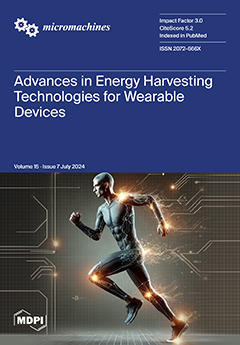Preparing elastic substrates as a carrier for dual-end supported nickel chromium thin film strain sensors is crucial. Wet etching is a vital microfabrication process widely used in producing microelectronic components for various applications. This article combines lithography and wet etching methods to microprocess the external dimensions and rectangular grooves of 304 stainless steel substrates. The single-factor variable method was used to explore the influence mechanism of FeCl
3, HCl, HNO
3, and temperature on the etching rate, etching factor, and etching surface roughness. The optimal etching parameter combination was summarized: an FeCl
3 concentration of 350 g/L, HCl concentration of 150 mL/L, HNO
3 concentration of 100 mL/L, and temperature of 40 °C. In addition, by comparing the surface morphology, microstructure, and chemical and mechanical properties of a 304 stainless steel substrate before and after etching treatment, it can be seen that the height difference of the substrate surface before and after etching is between 160 μm and −70 μm, which is basically consistent with the initial design of 0.2 mm. The results of an XPS analysis and Raman spectroscopy analysis both indicate that the surface C content increases after etching, and the corrosion resistance of the surface after etching decreases. The nano-hardness after etching increased by 26.4% compared to before, and the
ζ value decreased by 7%. The combined XPS and Raman results indicate that the changes in surface mechanical properties of 304 stainless steel substrates after etching are mainly caused by the formation of micro-nanostructures, grain boundary density, and dislocations after wet etching. Compared with the initial rectangular substrate, the strain of the I-shaped substrate after wet etching increased by 3.5–4 times. The results of this study provide the preliminary process parameters for the wet etching of a 304 stainless steel substrate of a strain measuring force sensor and have certain guiding significance for the realization of simple steps and low cost of 304 stainless steel substrate micro-nano-processing.
Full article






